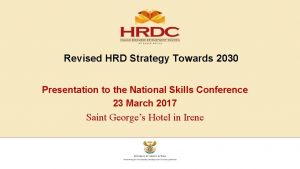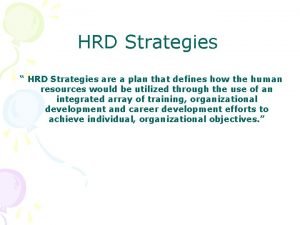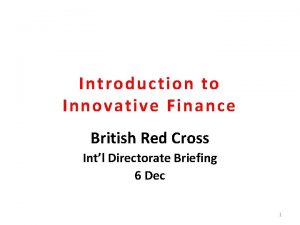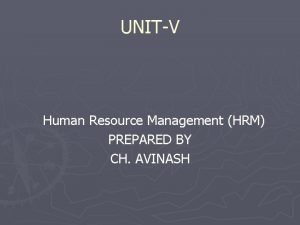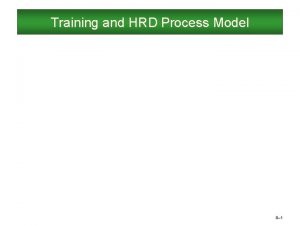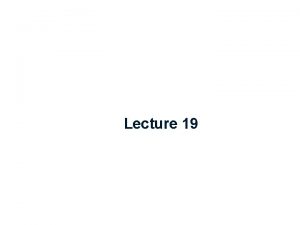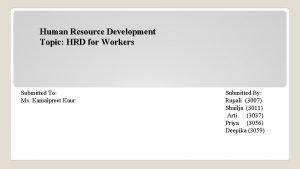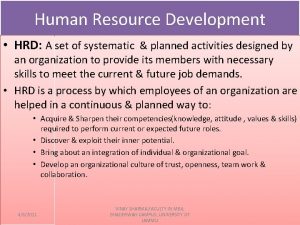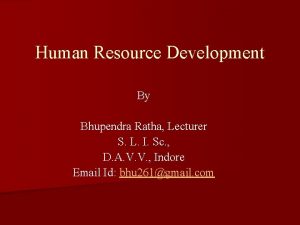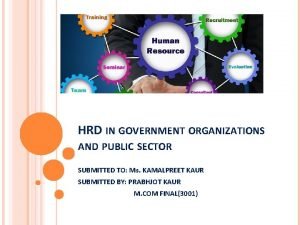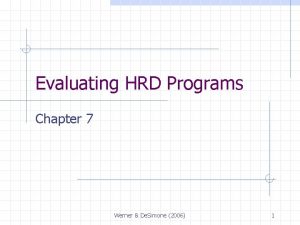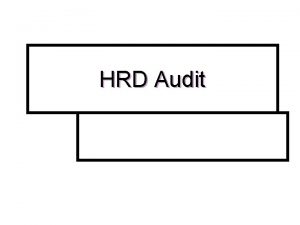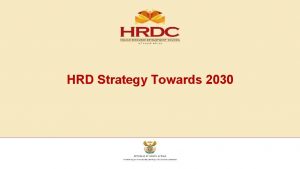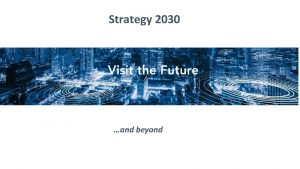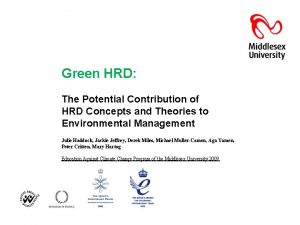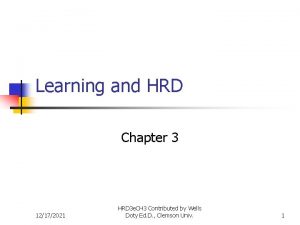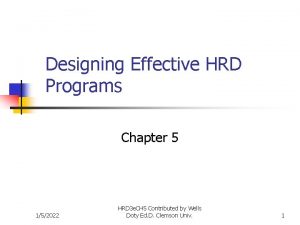Revised HRD Strategy Towards 2030 Presentation to the















- Slides: 15

Revised HRD Strategy Towards 2030 Presentation to the National Skills Conference 23 March 2017 Saint George’s Hotel in Irene

Presentation Outline • • • Background HRDSA: Vision and Mission HRD System Policy Framework HRDSA: Theory of Change Strategic goals Programme Priorities to address Key Imperatives Strategic objectives HRDC Planning, Monitoring, Reporting and Evaluation 2

Background • The Human Resource Development Strategy (HRDSA) is a coordination framework. • Intended to combine the key levers of the constituent parts of the HRD system. • The HRD subsystems (the occupational learning system e. g. SETA’s TVET, and the Technology and Innovation Systems) have detailed strategic priorities, inputs, outputs and performance indicators. • The HRD strategy must be greater than the sum of parts. 3

Background • The Strategy needs to: Ø Bring about articulation between subsystems. Ø Facilitate holistic analyses of HRD and the functioning of the labour market. Ø Link both of these to the economic development strategy Ø Deal with shortcomings in labour market information. Ø Ensure economies of scale with regard to complex analytical work. Ø Initiate activities which cannot be performed in any of the subsystems 4

Vision and Mission Mission Vision Partnering to innovatively develop human potential. • Advise the government on the HRD Strategy and its priorities • Identify blockages , provide solution to unblock them and monitor implementation thereof • Coordinate the efforts of government departments and social partners in the implementation of the strategy • Monitor and report on the implementation of the strategy • Evaluate the impact of the strategy against agreed indicators 5

HRD System NQF LEVEL 9/10 8 7 5/6 2 -4 1 THE HUMAN RESOURCE DEVELOPMENT SYSTEM IN SOUTH AFRICA Higher Education Research, Innovation, Knowledge Creation Universities Skills Development System Including Worker TVET & Other Colleges e. g. Agriculture, Nursing Education Training Agriculture, Nursing etc. FET Phase Schooling Community Colleges and NGOs Employer Training & Worker Education (Grade 10 -12) Senior Phase Schooling (Grade 7 -9) Intermediate Phase (Grade 4 -6) Foundational Phase Schooling (Grade 1 -3) Grade R (Age 5 -6) Early Childhood Development (Age 0 -4) 6

Policy Framework Related to HRD Provincial Growth and Development Strategies Municipal Integrated Development Plans Industrial Policy Action Plan Medium Term Strategic Framework National Development Plan POA-14 Priority Outcomes 9 Point Plan Skills Development Broad Based Act Black Economic Empowerment 7

HRDSA: Theory of Change Outcomes 1. Expanded access to quality education and training delivered by effective teachers/lecturers/academics in functional institutions; 2. Increased access WIL opportunities 3. Improvement in throughput and pass rates 4. Increased numbers of publication and innovation, Interventions Underpinning approach 1. Internationally HRD Councils are viewed as a unifying force and catalyst for performance excellence central to driving HRD change. Assumptions 2. HRD Council is well placed to play this role, of guiding and shaping HRD, enabling dialogue and consensus 1. HRD activities take place in a range of spaces and building, identifying skills blockages and finding solutions. spheres/ needs to be foregrounded/ requires collective engagement within and across government and with other social partners/ a political environment that supports collaboration and the policies that support inclusive growth and social development. Theory of change 1. Monitor the extent to which HRD targets are being met. 2. Understand the blockages where targets are not being met. 3. Collectively agree on how the blockage (s) will be 8

Strategic Goals 1. Strengthen basic education and foundation programmes in Science, Technology, Engineering, Maths , Languages and Life Orientation/Skills 2. Expanded access to quality post-schooling education and training 3. Production of appropriately skilled people for the economy 4. A Developmental/ capable state with effective and efficient planning and implementation capabilities 5. Improved research and technological innovation outcomes. 9

Programme priorities to address key imperatives Programme 1: Foundation Education with Science, Technology, Engineering, Maths and Languages and Life Orientation/Skills Programme 2: TVET and the Rest of the College System Programme 3: Higher Education and Training, Research and Innovation Programme 4: Skills for the transformed society and the economy Programme 5: Developmental/capable state 10

Strategic Objectives Programme 1: Foundation Education with Science, Technology, Engineering, Maths and Languages and Life Orientation/Skills • • SO 1: Improve, science, technology, engineering, maths and language systemic and matric results SO 2: Achieve universal access to quality pre-school Early Childhood Development Programme 2: TVET and the rest of the College System • • • SO 1: Forge strong linkages between universities and TVET colleges and the rest of College System to improve the standard of technical and vocational teaching SO 2: Improve the supply of FET and inter-mediate level occupations that are in high demand SO 3: Improve the supply of FET and inter-mediate level occupations that are in high demand SO 4: Build strong linkages and relationships with employers in the delivery of priority programmes SO 5: Ensure that young unemployed people participate in technical and vocational training in programmes that assist them to enter the labour market SO 6: Provide support and advice to learners (student support services for Vocational and Continuing Education and Training) 11

Strategic Objectives continue… Programme 3: Higher Education, Training, Research and Innovation • • SO 1: Increase the number of academics to achieve the planned expansion of university students and improve the equity profile of academics SO 2: Increase the number of academics to achieve the planned expansion of university students and improve the equity profile of academics SO 3: Improve the supply of HE level occupations that are in high demand, including professionals/ Increase access to high-level occupationally directed programmes in needed areas SO 4: Establish effective partnerships to enable research and innovation and its conversion into commercially viable products, processes & services • • • SO 5: Establish effective partnerships to enable research and innovation and its conversion into commercially viable products, processes & services SO 6: Providing schools, TVET and Community Colleges with appropriately qualified teachers and programmes to support their continuing professional development SO 7: Develop skills for the green economy 12

Strategic Objectives continue… Programme 4: Skills for the transformed society and the economy using workplace as a platform • • SO 1: Ensure that the demand for skills is researched, documented and communicated effectively to enable improved supply and demand SO 2: Put in place a skills system that is effective in brokering partnerships to address priority skills needs in the economy SO 3: Improve skills profile of SME, informal trade sector, rural people, women People with disability (PWD) and Not in employment, Education or Training (NEET) SO 4: Improve the skills profile of the employed workforce to enable greater levels of productivity and adaptability to the changing needs of the labour market Programme 5: Developmental/Capable state • • • SO 1: Establish partnerships to ensure the supply of quality management and specialist personnel for public service SO 2: Expand participation of government departments and entities in the provision of workplace training in priority skills needs SO 3: Expand the capacity of the state to drive economic and industrial development 13

HRDC planning, monitoring, reporting and evaluation Planning • 20 years long term plan (HRD Strategy); • 5 years implementation plan (NIHRD Plan); • 3 years HRDC Secretariat strategic plan in line with MTSF; and • 1 year HRDC Secretariat annual plan. Monitoring & Reporting • Quarterly performance reports by provinces; • Midterm reports; • Lead Department reports; and • HRDC annual report. Evaluation Types of evaluation every 5 years: • Baseline Evaluation: 2010 • Formative Evaluation: 2015 • Midterm evaluation: 2020 • Summative evaluation: 2025 • Impact evaluation: 2030 14

THANK YOU!! 15
